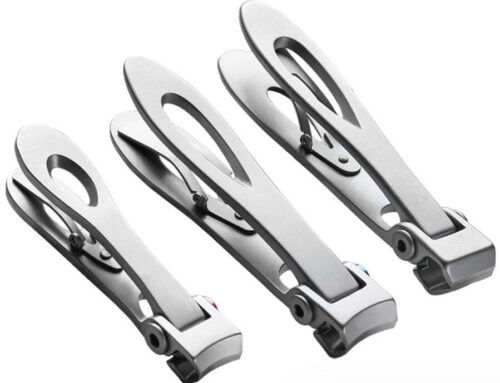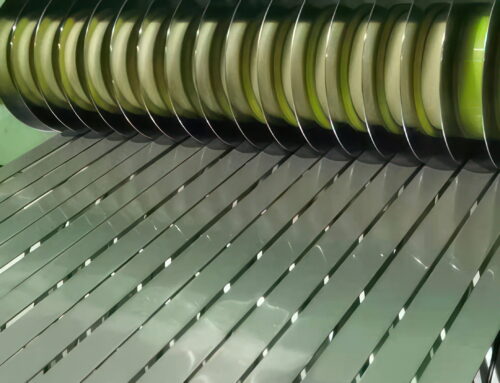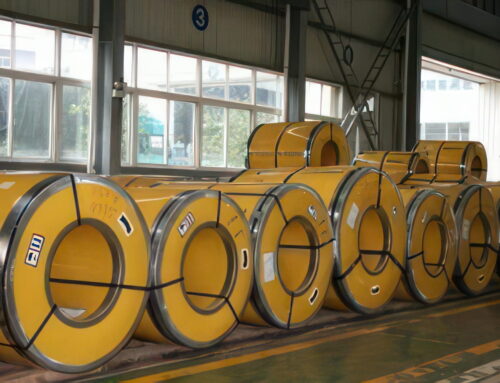AISI 304 Stainless Steel (UNS S30400, SS 304)
AISI 304 stainless steel (UNS S30400) is the most widely used stainless steel, containing 18-20% Cr and 8-10.5% Ni, and also known as 18-8 stainless steel. SS 304 is non-magnetic under annealing conditions, but after cold working (such as stamping, stretching, bending, rolling), part of the austenite structure may be converted into martensite and therefore weakly magnetic. Type 304 has good resistance to atmospheric corrosion and oxidation. The high nickel-chromium alloy content gives it excellent corrosion resistance and is widely used in the food industry as a standard food grade stainless steel.
There are several variants of 304 grade stainless steel, such as ultra-low-carbon version type 304L, nitrogen-containing version 304N, 304H with improved creep performance, and type 302 with higher carbon content. The second most widely used 316 grade stainless steel, compared with AISI 304, reduced chromium content, increased nickel content, and added 2-3% molybdenum. The addition of molybdenum can enhance the resistance to pitting and crevice corrosion caused by chloride. Therefore, 316 SS is widely used in marine applications.
SS 304 Stainless Steel Properties
The following tables give SS 304 stainless steel properties and specifications (datasheet) including chemical composition, physical and mechanical properties, heat treatment, corrosion resistance, machinability and machining, welding, etc.
Chemical Composition
AISI 304 stainless steel chemical composition is listed in the following table.
| Type 304 Stainless Steel Composition, % | |||||||||
| ASTM Standard | AISI (UNS) | C, ≤ | Si, ≤ | Mn, ≤ | P, ≤ | S, ≤ | Cr | Ni | N, ≤ |
| ASTM A240/A240M | 304 (UNS S30400) | 0.07 | 0.75 | 2.00 | 0.045 | 0.03 | 17.5-19.5 | 8.0-10.5 | 0.1 |
| ASTM A276/A276M | 0.08 | 1.00 | 2.00 | 0.045 | 0.03 | 18.0-20.0 | 8.0-11.0 | – | |
| ASTM 666; SAE J405 |
0.08 | 0.75 | 2.00 | 0.045 | 0.03 | 18.0-20.0 | 8.0-10.5 | 0.1 | |
| ASTM A313/A313M | 0.08 | 1.00 | 2.00 | 0.045 | 0.03 | 18.0-20.0 | 8.0-10.5 | 0.1 | |
| ASTM A479/A479M | 0.08 | 1.00 | 2.00 | 0.045 | 0.03 | 18.0-20.0 | 8.0-10.5 | – | |
| ASTM A314; ASTM A580/A580M |
0.08 | 1.00 | 2.00 | 0.045 | 0.03 | 18.0-20.0 | 8.0-10.5 | 0.1 | |
| ASTM A473 | 0.08 | 1.00 | 2.00 | 0.045 | 0.03 | 18.0-20.0 | 8.0-11.0 | 0.1 | |
| ASTM A959 | 0.07 | 1.00 | 2.00 | 0.045 | 0.03 | 17.5-19.5 | 8.0-11.0 | – | |
Notes:
- ASTM A240/A240M: Chromium and Chromium-Nickel Stainless Steel Plate, Sheet, and Strip for Pressure Vessels and for General Applications
- ASTM A276/A276M: Stainless Steel Bars and Shapes
- ASTM A313/A313M: Stainless Steel Spring Wire
- ASTM A314: Stainless Steel Billets and Bars for Forging
- ASTM A473: Stainless Steel Forgings
- ASTM A479/A479M: Stainless Steel Bars and Shapes for Use in Boilers and Other Pressure Vessels
- ASTM A580/A580M: Stainless Steel Wire
- ASTM 666: Annealed or Cold-Worked Austenitic Stainless Steel Sheet, Strip, Plate, and Flat Bar
- ASTM A959: Standard Guide for Specifying Harmonized Standard Grade Compositions for Wrought Stainless Steels
- SAE J405: Chemical Composition of SAE Wrought Stainless Steels
Physical Properties
SS 304 stainless steel physical properties are listed in the table below such as density, melting point, specific heat, electrical resistivity, elastic modulus (modulus of elasticity), thermal conductivity, and coefficient of thermal expansion (CTE).
Notes:
- 10-6·K-1 = 10-6/K
- 1 Ω·mm²/m = 1 μΩ·m
- 1 g/cm3 = 1 kg/dm3 = 1000 kg/m3
- 1 GPa = 1 kN/mm2
- 1 MPa = 1 N/mm2
| Type 304 Stainless Steel Physical Properties | |
| Density, g/cm3 (lb/in3) | 7.93 (0.286) |
| Melting point, °C (°F) | 1400-1450 (2550-2650) |
| Specific heat capacity, J/kg·K (Btu/lb ·°F) | 500 (0.12) at 20 °C (68 °F) |
| Electrical resistivity, μΩ·m | 0.72 at 20 °C (68 °F) |
| Conductivity, %, IACS | 2.5 |
| Magnetic permeability | 1.02 (Approximate) |
| Elastic modulus (Modulus of Elasticity), GPa (106 psi) | 193 (28) |
| Thermal diffusivity, mm2/s (in2/s) | 3.84 (0.006) |
| Thermal conductivity, W/m·K (Btu/ft·h·°F) | 16.2 (9.4) at 100 °C (212 °F) |
| 21.5 (12.4) at 500 °C (932 °F) | |
| Coefficient of thermal expansion (CTE), 10-6/K (μin./in·°F) | 17.2 (9.6) at 0-100 °C (32-212 °F) |
| 17.8 (9.9) at 0-315 °C (32-600 °F) | |
| 18.4 (10.2) at 0-538 °C (32-1000 °F) | |
AISI 304 Stainless Steel Mechanical Properties
AISI 304 stainless steel mechanical properties are given in the datasheet below including tensile strength, yield strength, elongation, reduction in area, Brinell and Rockwell hardness, etc.
Data are from professional, authoritative and trustworthy ASTM standards.
| ASTM A276 Type 304 Stainless Steel Mechanical Properties | ||||||
| ASTM | AISI (UNS) | Tensile Strength, Mpa (ksi), ≥ | 0.2% Yield Strength, Mpa (ksi), ≥ | Elongation in 2 in. (50 mm), %, ≥ | Reduction of Area, %, ≥ | Conditions |
| ASTM A276/A276M | 304 (UNS S30400), 304LN (UNS S30453) |
515 (75) | 205 (30) | 40 | 50 | Annealed, Hot finished |
| 620 (90) | 310 (45) | 30 | 40 | Annealed, Cold finished, Dia ≤ 1/2 in (12.7mm) | ||
| 515 (75) | 205 (30) | 30 | 40 | Annealed, Cold finished, Dia > 1/2 in (12.7mm) | ||
| ASTM A240 Type 304 Steel Mechanical Properties | ||||||
| ASTM | AISI (UNS) | Tensile Strength, Mpa (ksi), ≥ | 0.2% Yield Strength, Mpa (ksi), ≥ | Elongation in 2 in. (50 mm), %, ≥ | Brinell Hardness, HB, ≤ | Rockwell Hardness, HRB, ≤ |
| ASTM A240/A240M | 304 (UNS S30400) | 515 (75) | 205 (30) | 40 | 201 | 92 |
| ASTM A666 Type 304 Mechanical Properties | |||||||
| ASTM Standard | AISI Type (UNS) | Conditions | Tensile Strength, MPa (ksi), ≥ | 0.2% Yield Strength, MPa (ksi), ≥ | Elongation in 50 mm (2 in.), %, ≥ | Brinell Hardness (HB), ≤ | Rockwell Hardness (HRB), ≤ |
| ASTM A666 | 304 (UNS S30400) | Annealed | 517 (75) | 205 (30) | 40 | 201 | 92 |
| 1/2 Hard (Half Hard) | 1035 (150) | 760 (110) | 6 (<0.015 in); 7 (≥ 0.015 in) |
||||
| 1/4 (Quarter-hard) Hard | 862 (125) | 517 (75) | 10 (≤ 0.03 in); 12 (> 0.03 in) |
||||
| 1/8 Hard | 690 (100) | 380 (55) | 35 | ||||
| plate, strip, sheet | 1/16 Hard | 550 (80) | 310 (45) | 40 | |||
| 304 flat bar | 620 (90) | 310 (45) | 40 (>0.030 in) | ||||
| ASTM A313 Type 304 Stainless Steel Spring Wire Tensile Strength Requirements | ||||
| Diameter (d), in. | Diameter (d), mm | Bend Test, Minimum Number of Bends | ksi | MPa |
| ≤0.009 | ≤0.23 | – | 325-355 | 2240-2450 |
| 0.009<d≤0.010 | 0.23<d≤0.25 | – | 320-350 | 2205-2415 |
| 0.010<d≤0.011 | 0.25<d≤0.28 | – | 318-348 | 2190-2400 |
| 0.011<d≤0.012 | 0.28<d≤0.30 | – | 316-346 | 2180-2385 |
| 0.012<d≤0.013 | 0.30<d≤0.33 | – | 314-344 | 2165-2370 |
| 0.013<d≤0.014 | 0.33<d≤0.36 | – | 312-342 | 2150-2360 |
| 0.014<d≤0.015 | 0.36<d≤0.38 | – | 310-340 | 2135-2345 |
| 0.015<d≤0.016 | 0.38<d≤0.41 | – | 308-338 | 2125-2330 |
| 0.016<d≤0.017 | 0.41<d≤0.43 | – | 306-336 | 2110-2315 |
| 0.017<d≤0.018 | 0.43<d≤0.46 | – | 304-334 | 2095-2300 |
| 0.018<d≤0.020 | 0.46<d≤0.51 | – | 300-330 | 2070-2275 |
| 0.020<d≤0.022 | 0.51<d≤0.56 | – | 296-326 | 2040-2250 |
| 0.022<d≤0.024 | 0.56<d≤0.61 | – | 292-322 | 2015-2220 |
| 0.024<d≤0.026 | 0.61<d≤0.66 | – | 291-320 | 2005-2205 |
| 0.026<d≤0.028 | 0.66<d≤0.71 | 8 | 289-318 | 1995-2190 |
| 0.028<d≤0.031 | 0.71<d≤0.79 | 8 | 285-315 | 1965-2170 |
| 0.031<d≤0.034 | 0.79<d≤0.86 | 8 | 282-310 | 1945-2135 |
| 0.034<d≤0.037 | 0.86<d≤0.94 | 8 | 280-308 | 1930-2125 |
| 0.037<d≤0.041 | 0.94<d≤1.04 | 8 | 275-304 | 1895-2095 |
| 0.041<d≤0.045 | 1.04<d≤1.14 | 8 | 272-300 | 1875-2070 |
| 0.045<d≤0.050 | 1.14<d≤1.27 | 8 | 267-295 | 1840-2035 |
| 0.050<d≤0.054 | 1.27<d≤1.37 | 8 | 265-293 | 1825-2020 |
| 0.054<d≤0.058 | 1.37<d≤1.47 | 7 | 261-289 | 1800-1990 |
| 0.058<d≤0.063 | 1.47<d≤1.60 | 7 | 258-285 | 1780-1965 |
| 0.063<d≤0.070 | 1.60<d≤1.78 | 7 | 252-281 | 1735-1935 |
| 0.070<d≤0.075 | 1.78<d≤1.90 | 7 | 250-278 | 1725-1915 |
| 0.075<d≤0.080 | 1.90<d≤2.03 | 7 | 246-275 | 1695-1895 |
| 0.080<d≤0.087 | 2.03<d≤2.21 | 7 | 242-271 | 1670-1870 |
| 0.087<d≤0.095 | 2.21<d≤2.41 | 7 | 238-268 | 1640-1850 |
| 0.095<d≤0.105 | 2.41<d≤2.67 | 5 | 232-262 | 1600-1805 |
| 0.105<d≤0.115 | 2.67<d≤2.92 | 5 | 227-257 | 1565-1770 |
| 0.115<d≤0.125 | 2.92<d≤3.17 | 5 | 222-253 | 1530-1745 |
| 0.125<d≤0.135 | 3.17<d≤3.43 | 3 | 217-248 | 1495-1710 |
| 0.135<d≤0.148 | 3.43<d≤3.76 | 3 | 210-241 | 1450-1660 |
| 0.148<d≤0.162 | 3.76<d≤4.11 | 3 | 205-235 | 1415-1620 |
| 0.162<d≤0.177 | 4.11<d≤4.50 | 3 | 198-228 | 1365-1570 |
| 0.177<d≤0.192 | 4.50<d≤4.88 | 1 | 194-225 | 1335-1550 |
| 0.192<d≤0.207 | 4.88<d≤5.26 | 1 | 188-220 | 1295-1515 |
| 0.207<d≤0.225 | 5.26<d≤5.72 | 1 | 182-214 | 1255-1475 |
| 0.225<d≤0.250 | 5.72<d≤6.35 | 1 | 175-205 | 1205-1415 |
| 0.250<d≤0.278 | 6.35<d≤7.06 | 1 | 168-198 | 1160-1365 |
| 0.278<d≤0.306 | 7.06<d≤7.77 | 1 | 161-192 | 1110-1325 |
| 0.306<d≤0.331 | 7.77<d≤8.41 | 1 | 155186 | 1070-1280 |
| 0.331<d≤0.362 | 8.41<d≤9.19 | 1 | 150-180 | 1035-1240 |
| 0.362<d≤0.394 | 9.19<d≤10.00 | 1 | 145-175 | 1000-1205 |
| 0.394<d≤0.438 | 10.00<d≤11.12 | 1 | 140-170 | 965-1170 |
| 0.438<d≤0.500 | 11.12<d≤12.70 | 1 | 135-165 | 930-1140 |
| >0.500 | >12.70 | – | 130-160 | 895-1105 |
| When wire is specified in straightened and cut lengths, the minimum tensile strength shall be 90 % of the values listed in the table. | ||||
| ASTM A473 Type 304 Mechanical Properties | |||||||
| ASTM | AISI (UNS) | Tensile Strength, Mpa (ksi), ≥ | 0.2% Yield Strength, Mpa (ksi), ≥ | Elongation in 2 in. (50 mm), %, ≥ | Reduction of Area, %, ≥ | Sections | Conditions |
| ASTM A473/A473M | 304 (UNS S30400) | 515 (75) | 205 (30) | 40 | 50 | ≤ 5 in. (127 mm) | Annealed |
| 485 (70) | > 5 in. (127 mm) | Annealed | |||||
| ASTM A479 Type 304 Mechanical Properties | ||||||
| ASTM | AISI (UNS) | Tensile Strength, Mpa (ksi), ≥ | 0.2% Yield Strength, Mpa (ksi), ≥ | Elongation in 2 in. (50 mm), %, ≥ | Reduction of Area, %, ≥ | Conditions |
| ASTM A479/A479M | 304, 304H, 304LN | 515 (75) | 205 (30) | 30 | 40 | Annealed |
| ASTM A580 Type 304 Mechanical Properties | ||||||
| ASTM | AISI (UNS) | Tensile Strength, Mpa (ksi), ≥ | 0.2% Yield Strength, Mpa (ksi), ≥ | Elongation in 2 in. (50 mm), %, ≥ | Reduction of Area, %, ≥ | Conditions |
| ASTM A580/A580M | SS 304 (UNS S30400) | 620 (90) | 310 (45) | 30 | 40 | Annealed, cold finished |
| 515 (75) | 205 (30) | 35 | 50 | Annealed | ||
Type 304 Stainless Steel Heat Resistance
| Maximum service temperature in air | ||
| AISI type | Intermittent service | Continuous service |
| 304 | 870 °C (1600 °F) | 925 °C (1700 °F) |
Hardening
Conventional austenite such as AISI 304 stainless steel cannot be hardened by heat treatment, because they will not change their crystal lattice structure when heated, so they can only be hardened by cold working. Cold working will transform a part of austenite into martensite. As the amount of martensite in the steel increases, its strength increases and its plasticity decreases.
Corrosion Resistance
The reason why SS 304 material does not rust is because the Cr and Fe in it are oxidized to form a dense passive film to prevent further corrosion.
AISI 304 stainless steel has excellent corrosion resistance in mild atmosphere and fresh water, and even the surface will not rust. But it’s not resistant to halide (such as chloride, fluoride, etc.) corrosion, because the halide can easily penetrate the passive film and make stainless steel lose the resistance.
Welding of AISI 304 Grade Stainless Steel
Type 304 stainless steel has excellent weldability and does not require preheating. Generally, post-weld heat treatment is not required, unless large cross-sections are welded, or weld decay may occor.
To prevent weld decay, please refer to heat treatment-stress relief, or recommend the use of ultra-low carbon stainless steel such as 304L, or stabilized stainless steel 321, 347.





Leave A Comment